weight FORD E-450 2004 Owners Manual
[x] Cancel search | Manufacturer: FORD, Model Year: 2004, Model line: E-450, Model: FORD E-450 2004Pages: 240, PDF Size: 3.8 MB
Page 97 of 240
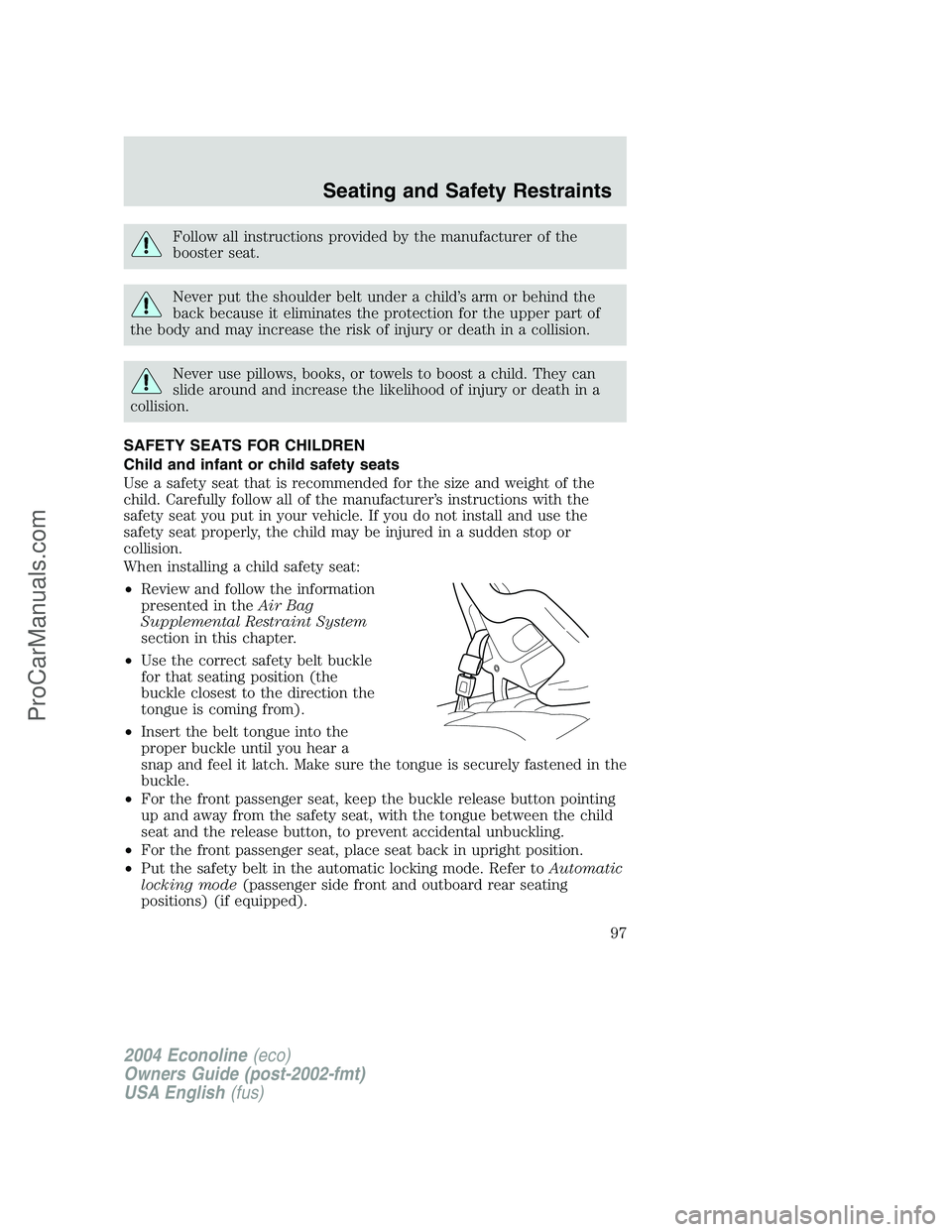
Follow all instructions provided by the manufacturer of the
booster seat.
Never put the shoulder belt under a child’s arm or behind the
back because it eliminates the protection for the upper part of
the body and may increase the risk of injury or death in a collision.
Never use pillows, books, or towels to boost a child. They can
slide around and increase the likelihood of injury or death in a
collision.
SAFETY SEATS FOR CHILDREN
Child and infant or child safety seats
Use a safety seat that is recommended for the size and weight of the
child. Carefully follow all of the manufacturer’s instructions with the
safety seat you put in your vehicle. If you do not install and use the
safety seat properly, the child may be injured in a sudden stop or
collision.
When installing a child safety seat:
•Review and follow the information
presented in theAir Bag
Supplemental Restraint System
section in this chapter.
•Use the correct safety belt buckle
for that seating position (the
buckle closest to the direction the
tongue is coming from).
•Insert the belt tongue into the
proper buckle until you hear a
snap and feel it latch. Make sure the tongue is securely fastened in the
buckle.
•For the front passenger seat, keep the buckle release button pointing
up and away from the safety seat, with the tongue between the child
seat and the release button, to prevent accidental unbuckling.
•For the front passenger seat, place seat back in upright position.
•Put the safety belt in the automatic locking mode. Refer toAutomatic
locking mode(passenger side front and outboard rear seating
positions) (if equipped).
2004 Econoline(eco)
Owners Guide (post-2002-fmt)
USA English(fus)
Seating and Safety Restraints
97
ProCarManuals.com
Page 114 of 240
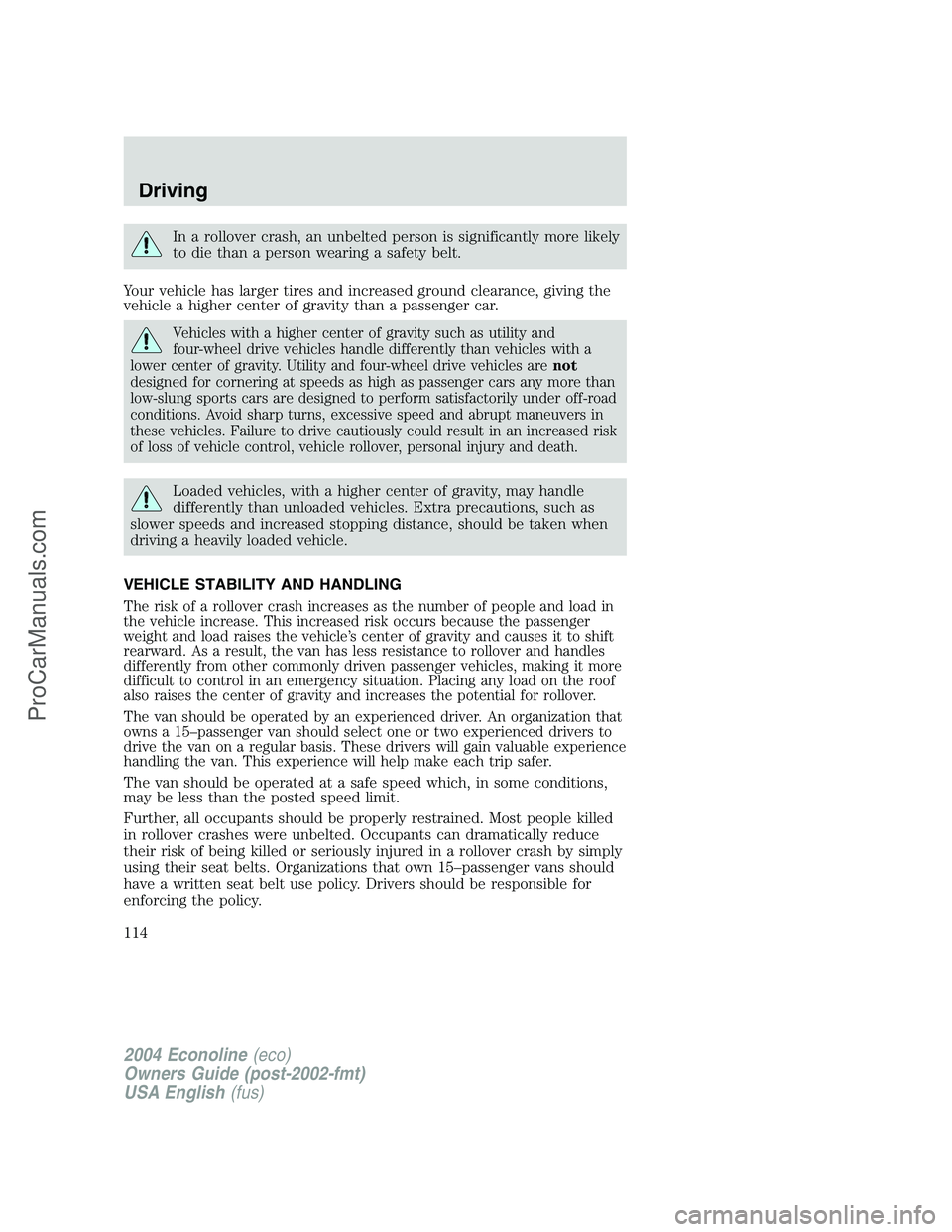
In a rollover crash, an unbelted person is significantly more likely
to die than a person wearing a safety belt.
Your vehicle has larger tires and increased ground clearance, giving the
vehicle a higher center of gravity than a passenger car.
Vehicles with a higher center of gravity such as utility and
four-wheel drive vehicles handle differently than vehicles with a
lower center of gravity. Utility and four-wheel drive vehicles arenot
designed for cornering at speeds as high as passenger cars any more than
low-slung sports cars are designed to perform satisfactorily under off-road
conditions. Avoid sharp turns, excessive speed and abrupt maneuvers in
these vehicles. Failure to drive cautiously could result in an increased risk
of loss of vehicle control, vehicle rollover, personal injury and death.
Loaded vehicles, with a higher center of gravity, may handle
differently than unloaded vehicles. Extra precautions, such as
slower speeds and increased stopping distance, should be taken when
driving a heavily loaded vehicle.
VEHICLE STABILITY AND HANDLING
The risk of a rollover crash increases as the number of people and load in
the vehicle increase. This increased risk occurs because the passenger
weight and load raises the vehicle’s center of gravity and causes it to shift
rearward. As a result, the van has less resistance to rollover and handles
differently from other commonly driven passenger vehicles, making it more
difficult to control in an emergency situation. Placing any load on the roof
also raises the center of gravity and increases the potential for rollover.
The van should be operated by an experienced driver. An organization that
owns a 15–passenger van should select one or two experienced drivers to
drive the van on a regular basis. These drivers will gain valuable experience
handling the van. This experience will help make each trip safer.
The van should be operated at a safe speed which, in some conditions,
may be less than the posted speed limit.
Further, all occupants should be properly restrained. Most people killed
in rollover crashes were unbelted. Occupants can dramatically reduce
their risk of being killed or seriously injured in a rollover crash by simply
using their seat belts. Organizations that own 15–passenger vans should
have a written seat belt use policy. Drivers should be responsible for
enforcing the policy.
2004 Econoline(eco)
Owners Guide (post-2002-fmt)
USA English(fus)
Driving
114
ProCarManuals.com
Page 120 of 240
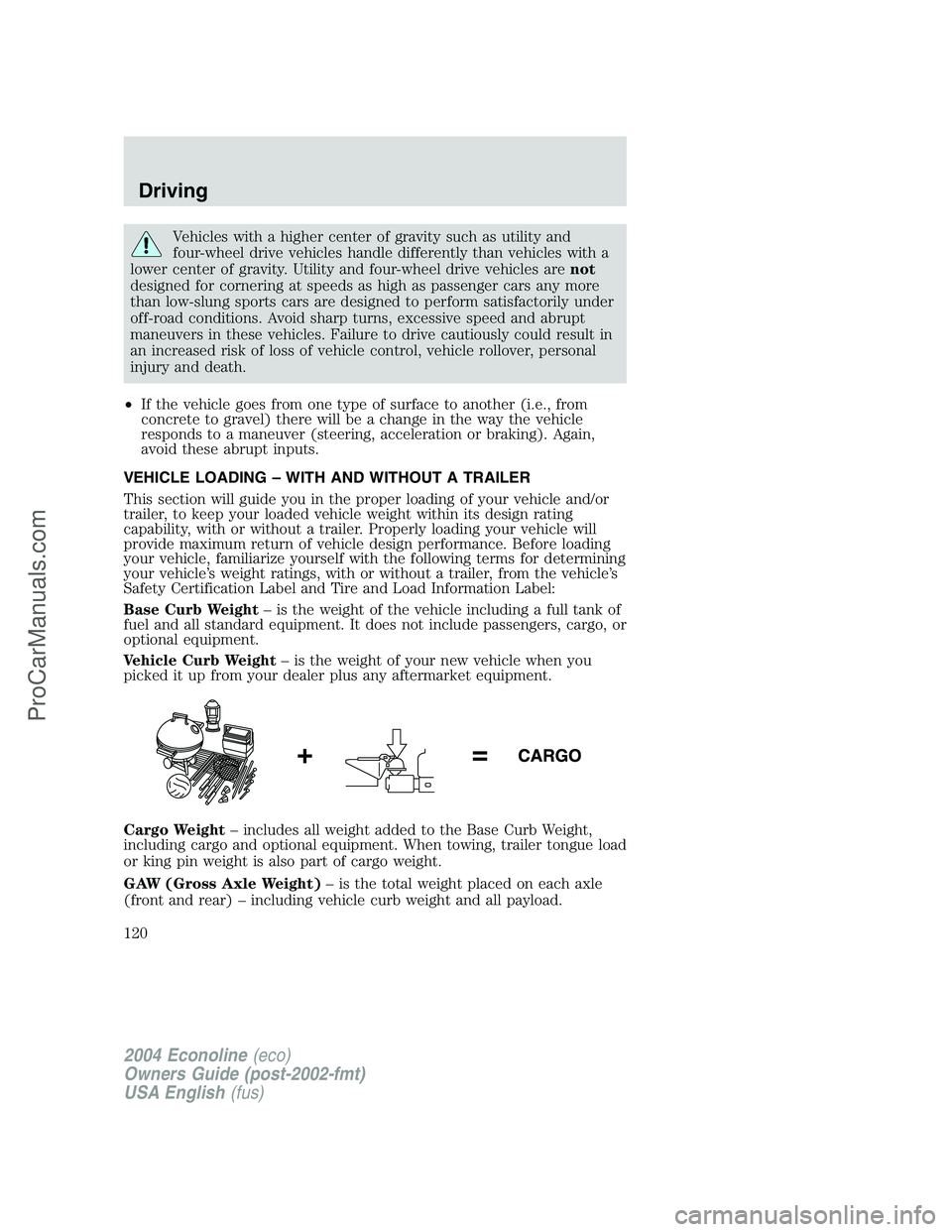
Vehicles with a higher center of gravity such as utility and
four-wheel drive vehicles handle differently than vehicles with a
lower center of gravity. Utility and four-wheel drive vehicles arenot
designed for cornering at speeds as high as passenger cars any more
than low-slung sports cars are designed to perform satisfactorily under
off-road conditions. Avoid sharp turns, excessive speed and abrupt
maneuvers in these vehicles. Failure to drive cautiously could result in
an increased risk of loss of vehicle control, vehicle rollover, personal
injury and death.
•If the vehicle goes from one type of surface to another (i.e., from
concrete to gravel) there will be a change in the way the vehicle
responds to a maneuver (steering, acceleration or braking). Again,
avoid these abrupt inputs.
VEHICLE LOADING–WITH AND WITHOUT A TRAILER
This section will guide you in the proper loading of your vehicle and/or
trailer, to keep your loaded vehicle weight within its design rating
capability, with or without a trailer. Properly loading your vehicle will
provide maximum return of vehicle design performance. Before loading
your vehicle, familiarize yourself with the following terms for determining
your vehicle’s weight ratings, with or without a trailer, from the vehicle’s
Safety Certification Label and Tire and Load Information Label:
Base Curb Weight–is the weight of the vehicle including a full tank of
fuel and all standard equipment. It does not include passengers, cargo, or
optional equipment.
Vehicle Curb Weight–is the weight of your new vehicle when you
picked it up from your dealer plus any aftermarket equipment.
Cargo Weight–includes all weight added to the Base Curb Weight,
including cargo and optional equipment. When towing, trailer tongue load
or king pin weight is also part of cargo weight.
GAW (Gross Axle Weight)–is the total weight placed on each axle
(front and rear)–including vehicle curb weight and all payload.
2004 Econoline(eco)
Owners Guide (post-2002-fmt)
USA English(fus)
Driving
120
ProCarManuals.com
Page 121 of 240

GAWR (Gross Axle Weight Rating)–is the maximum allowable
weight that can be carried by a single axle (front or rear).These
numbers are shown on the Safety Compliance Certification Label
located on the driver’s door or door pillar. The total load on each
axle must never exceed its GAWR.
Exceeding the Safety Certification Label axle weight rating limits
could result in substandard vehicle handling, performance,
engine, transmission and/or structural damage, serious damage to the
vehicle, loss of control and personal injury.
Note:For trailer towing information refer toTrailer Towingfound in
this chapter or the RV and Trailer Towing Guide provided by your
dealership.
GVW (Gross Vehicle Weight)–is the Vehicle Curb Weight + cargo +
passengers.
GVWR (Gross Vehicle Weight
Rating)–is the maximum
allowable weight of the fully loaded
vehicle (including all options,
equipment, passengers and cargo).
The GVWR is shown on the
Safety Compliance Certification
Label located on the driver’s
door or door pillar. The GVW
must never exceed the GVWR.
2004 Econoline(eco)
Owners Guide (post-2002-fmt)
USA English(fus)
Driving
121
ProCarManuals.com
Page 122 of 240

Exceeding the Safety Certification Label axle weight rating limits
could result in substandard vehicle handling, performance,
engine, transmission and/or structural damage, serious damage to the
vehicle, loss of control and personal injury.
GCW (Gross Combined Weight)–is the weight of the loaded vehicle
(GVW) plus the weight of the fully loaded trailer.
GCWR (Gross Combined Weight Rating)–is the maximum allowable
weight of the vehicle and the loaded trailer–including all cargo and
passengers–that the vehicle can handle without risking damage.
(Important: The towing vehicle’s braking system is rated for operation at
GVWR, not at GCWR. Separate functional brakes should be used for safe
control of towed vehicles and for trailers weighing more than 680 kg
[1,500 lbs]).The GCW must never exceed the GCWR.
Maximum Loaded Trailer Weight–is the highest possible weight of a
fully loaded trailer the vehicle can tow. It assumes a vehicle with only
mandatory options, no cargo (internal or external), a tongue load of
10–15% (conventional trailer) or king pin weight of 15–25% (fifth wheel
trailer), and driver only (68 kg [150 lbs]).Consult your dealership (or
the RV and Trailer Towing Guide provided by your dealership) for
more detailed information.
Tongue Load or Fifth Wheel King Pin Weight–refers to the amount
of the weight that a trailer pushes down on a trailer hitch.
Examples:For a 2268 kg (5000 lbs.) conventional trailer, multiply 5000
by 0.10 and 0.15 to obtain a proper tongue load range of 227 to 340 kg
(500 to 750 lbs.). For an 5216 kg (11,500 lbs.) fifth wheel trailer,
multiply by 0.15 and 0.25 to obtain a proper king pin load range of 782
to 1304 kg (1,725 to 2,875 lbs.)
Do not exceed the GVWR or the GAWR specified on the
certification label.
2004 Econoline(eco)
Owners Guide (post-2002-fmt)
USA English(fus)
Driving
122
ProCarManuals.com
Page 123 of 240
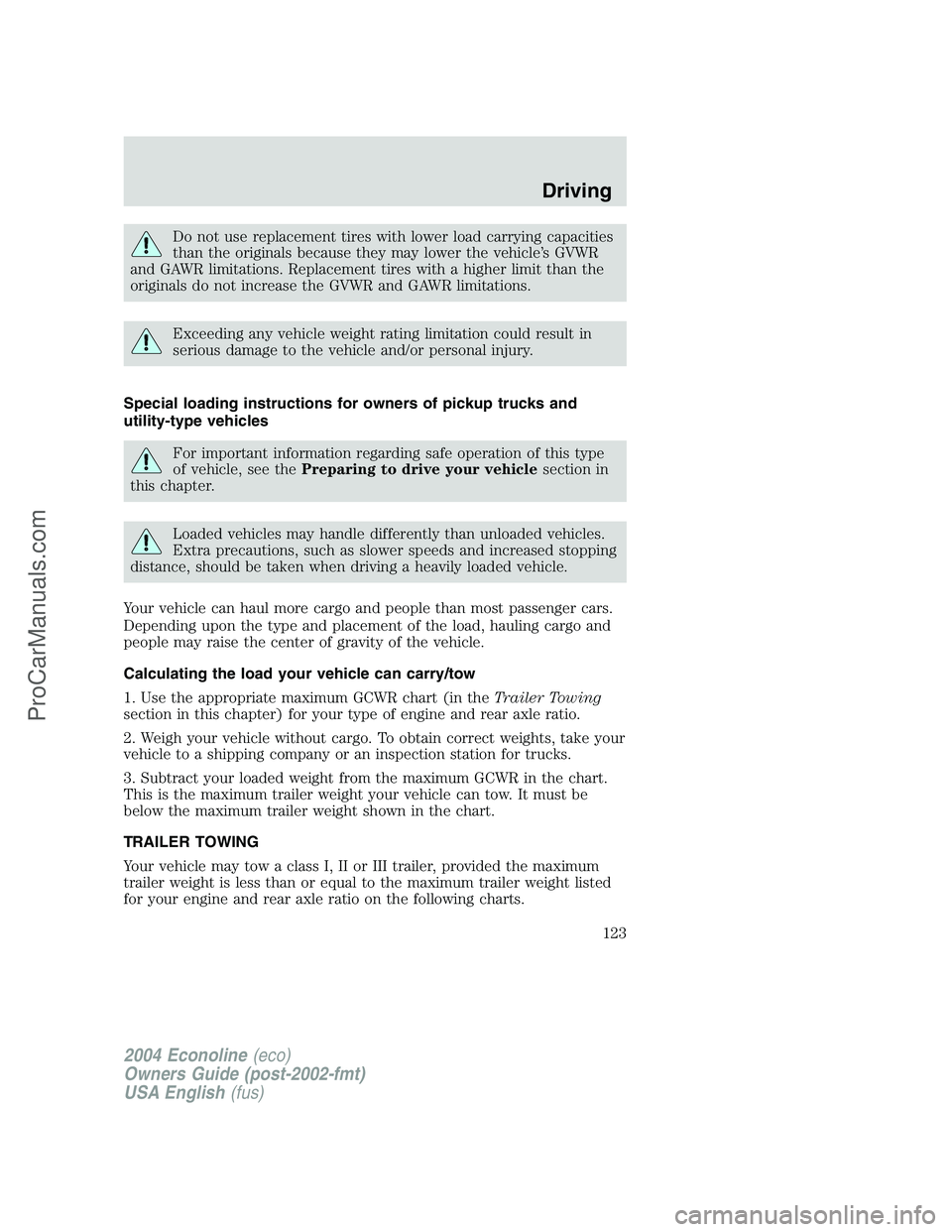
Do not use replacement tires with lower load carrying capacities
than the originals because they may lower the vehicle’s GVWR
and GAWR limitations. Replacement tires with a higher limit than the
originals do not increase the GVWR and GAWR limitations.
Exceeding any vehicle weight rating limitation could result in
serious damage to the vehicle and/or personal injury.
Special loading instructions for owners of pickup trucks and
utility-type vehicles
For important information regarding safe operation of this type
of vehicle, see thePreparing to drive your vehiclesection in
this chapter.
Loaded vehicles may handle differently than unloaded vehicles.
Extra precautions, such as slower speeds and increased stopping
distance, should be taken when driving a heavily loaded vehicle.
Your vehicle can haul more cargo and people than most passenger cars.
Depending upon the type and placement of the load, hauling cargo and
people may raise the center of gravity of the vehicle.
Calculating the load your vehicle can carry/tow
1. Use the appropriate maximum GCWR chart (in theTrailer Towing
section in this chapter) for your type of engine and rear axle ratio.
2. Weigh your vehicle without cargo. To obtain correct weights, take your
vehicle to a shipping company or an inspection station for trucks.
3. Subtract your loaded weight from the maximum GCWR in the chart.
This is the maximum trailer weight your vehicle can tow. It must be
below the maximum trailer weight shown in the chart.
TRAILER TOWING
Your vehicle may tow a class I, II or III trailer, provided the maximum
trailer weight is less than or equal to the maximum trailer weight listed
for your engine and rear axle ratio on the following charts.
2004 Econoline(eco)
Owners Guide (post-2002-fmt)
USA English(fus)
Driving
123
ProCarManuals.com
Page 124 of 240
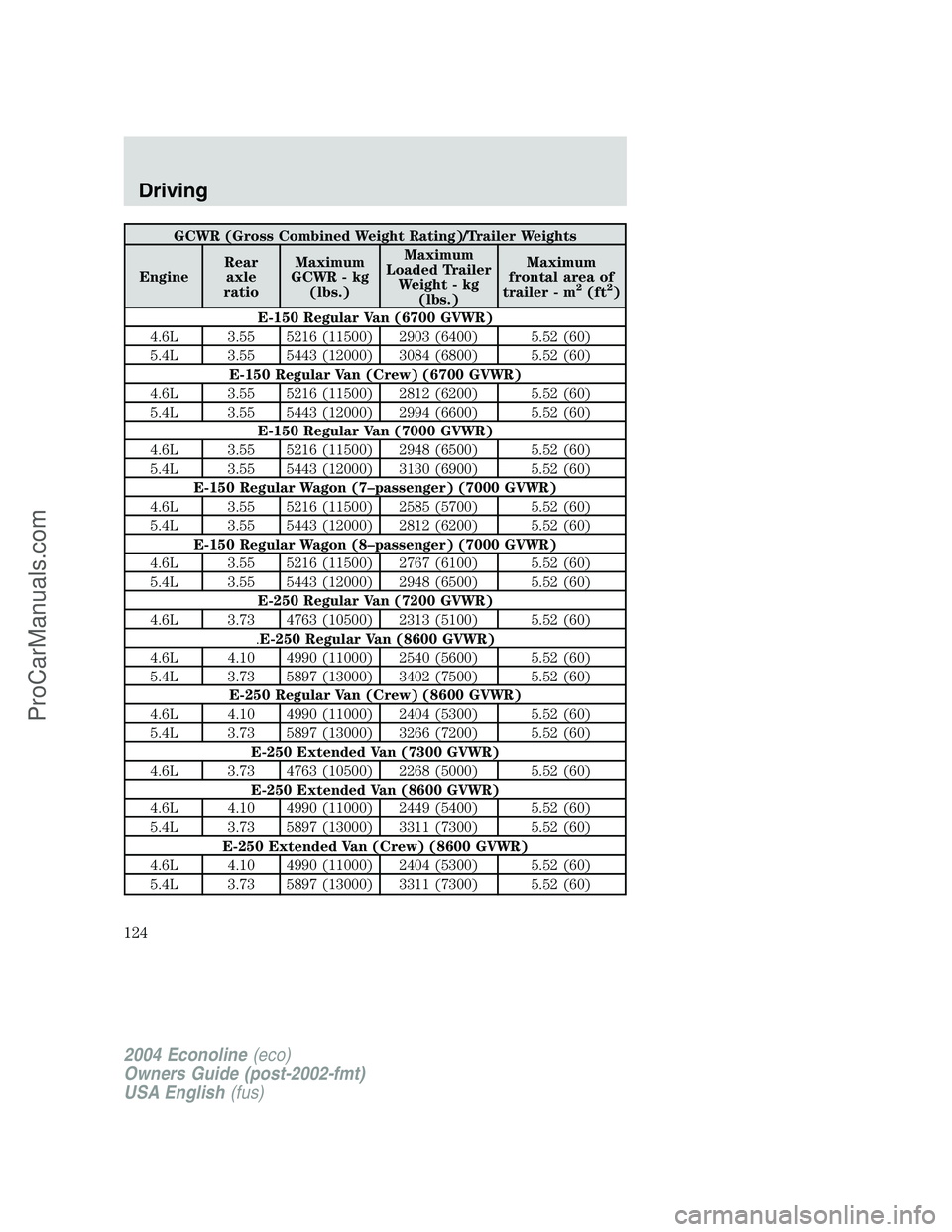
GCWR (Gross Combined Weight Rating)/Trailer Weights
EngineRear
axle
ratioMaximum
GCWR - kg
(lbs.)Maximum
Loaded Trailer
Weight - kg
(lbs.)Maximum
frontal area of
trailer - m
2(ft2)
E-150 Regular Van (6700 GVWR)
4.6L 3.55 5216 (11500) 2903 (6400) 5.52 (60)
5.4L 3.55 5443 (12000) 3084 (6800) 5.52 (60)
E-150 Regular Van (Crew) (6700 GVWR)
4.6L 3.55 5216 (11500) 2812 (6200) 5.52 (60)
5.4L 3.55 5443 (12000) 2994 (6600) 5.52 (60)
E-150 Regular Van (7000 GVWR)
4.6L 3.55 5216 (11500) 2948 (6500) 5.52 (60)
5.4L 3.55 5443 (12000) 3130 (6900) 5.52 (60)
E-150 Regular Wagon (7–passenger) (7000 GVWR)
4.6L 3.55 5216 (11500) 2585 (5700) 5.52 (60)
5.4L 3.55 5443 (12000) 2812 (6200) 5.52 (60)
E-150 Regular Wagon (8–passenger) (7000 GVWR)
4.6L 3.55 5216 (11500) 2767 (6100) 5.52 (60)
5.4L 3.55 5443 (12000) 2948 (6500) 5.52 (60)
E-250 Regular Van (7200 GVWR)
4.6L 3.73 4763 (10500) 2313 (5100) 5.52 (60)
.E-250 Regular Van (8600 GVWR)
4.6L 4.10 4990 (11000) 2540 (5600) 5.52 (60)
5.4L 3.73 5897 (13000) 3402 (7500) 5.52 (60)
E-250 Regular Van (Crew) (8600 GVWR)
4.6L 4.10 4990 (11000) 2404 (5300) 5.52 (60)
5.4L 3.73 5897 (13000) 3266 (7200) 5.52 (60)
E-250 Extended Van (7300 GVWR)
4.6L 3.73 4763 (10500) 2268 (5000) 5.52 (60)
E-250 Extended Van (8600 GVWR)
4.6L 4.10 4990 (11000) 2449 (5400) 5.52 (60)
5.4L 3.73 5897 (13000) 3311 (7300) 5.52 (60)
E-250 Extended Van (Crew) (8600 GVWR)
4.6L 4.10 4990 (11000) 2404 (5300) 5.52 (60)
5.4L 3.73 5897 (13000) 3311 (7300) 5.52 (60)
2004 Econoline(eco)
Owners Guide (post-2002-fmt)
USA English(fus)
Driving
124
ProCarManuals.com
Page 125 of 240
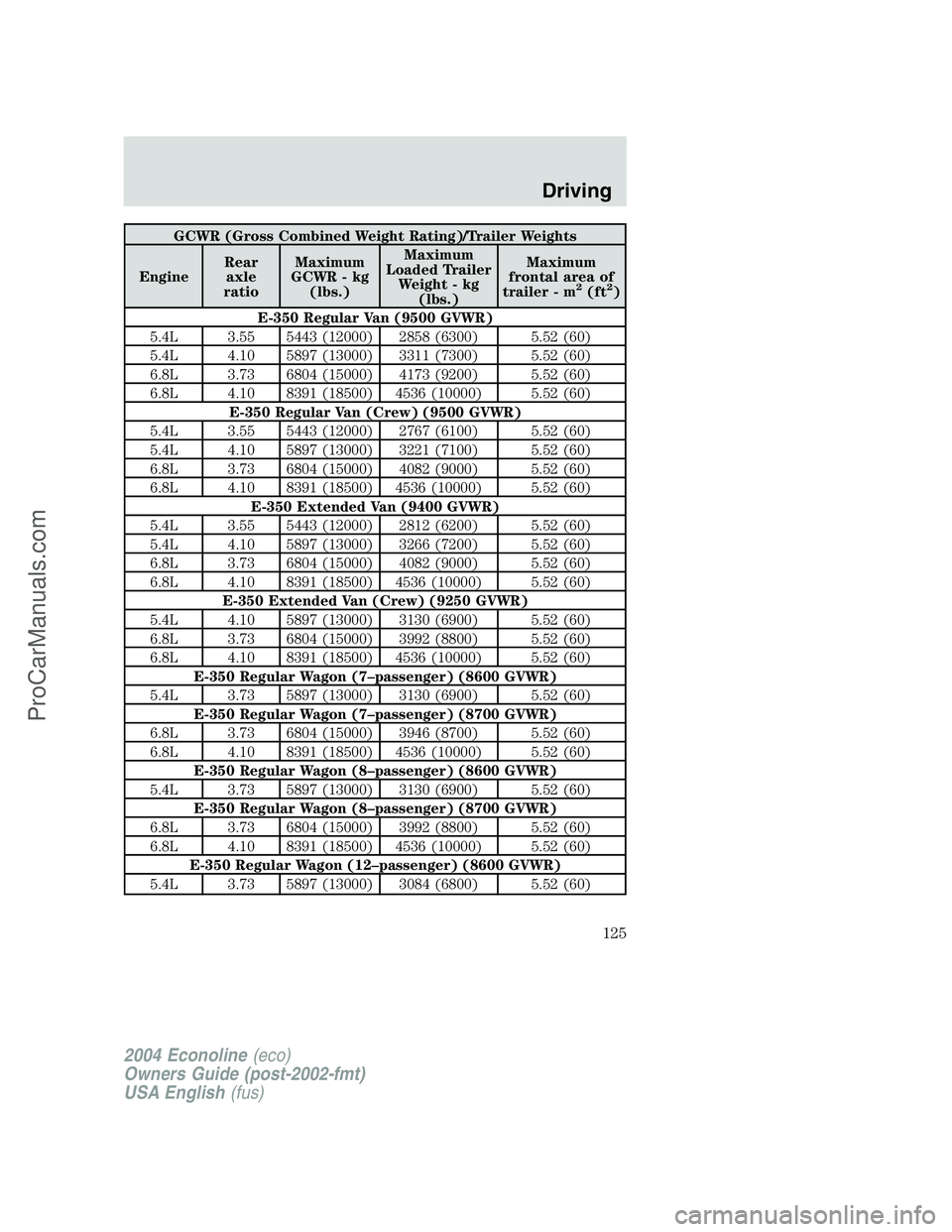
GCWR (Gross Combined Weight Rating)/Trailer Weights
EngineRear
axle
ratioMaximum
GCWR - kg
(lbs.)Maximum
Loaded Trailer
Weight - kg
(lbs.)Maximum
frontal area of
trailer - m
2(ft2)
E-350 Regular Van (9500 GVWR)
5.4L 3.55 5443 (12000) 2858 (6300) 5.52 (60)
5.4L 4.10 5897 (13000) 3311 (7300) 5.52 (60)
6.8L 3.73 6804 (15000) 4173 (9200) 5.52 (60)
6.8L 4.10 8391 (18500) 4536 (10000) 5.52 (60)
E-350 Regular Van (Crew) (9500 GVWR)
5.4L 3.55 5443 (12000) 2767 (6100) 5.52 (60)
5.4L 4.10 5897 (13000) 3221 (7100) 5.52 (60)
6.8L 3.73 6804 (15000) 4082 (9000) 5.52 (60)
6.8L 4.10 8391 (18500) 4536 (10000) 5.52 (60)
E-350 Extended Van (9400 GVWR)
5.4L 3.55 5443 (12000) 2812 (6200) 5.52 (60)
5.4L 4.10 5897 (13000) 3266 (7200) 5.52 (60)
6.8L 3.73 6804 (15000) 4082 (9000) 5.52 (60)
6.8L 4.10 8391 (18500) 4536 (10000) 5.52 (60)
E-350 Extended Van (Crew) (9250 GVWR)
5.4L 4.10 5897 (13000) 3130 (6900) 5.52 (60)
6.8L 3.73 6804 (15000) 3992 (8800) 5.52 (60)
6.8L 4.10 8391 (18500) 4536 (10000) 5.52 (60)
E-350 Regular Wagon (7–passenger) (8600 GVWR)
5.4L 3.73 5897 (13000) 3130 (6900) 5.52 (60)
E-350 Regular Wagon (7–passenger) (8700 GVWR)
6.8L 3.73 6804 (15000) 3946 (8700) 5.52 (60)
6.8L 4.10 8391 (18500) 4536 (10000) 5.52 (60)
E-350 Regular Wagon (8–passenger) (8600 GVWR)
5.4L 3.73 5897 (13000) 3130 (6900) 5.52 (60)
E-350 Regular Wagon (8–passenger) (8700 GVWR)
6.8L 3.73 6804 (15000) 3992 (8800) 5.52 (60)
6.8L 4.10 8391 (18500) 4536 (10000) 5.52 (60)
E-350 Regular Wagon (12–passenger) (8600 GVWR)
5.4L 3.73 5897 (13000) 3084 (6800) 5.52 (60)
2004 Econoline(eco)
Owners Guide (post-2002-fmt)
USA English(fus)
Driving
125
ProCarManuals.com
Page 126 of 240
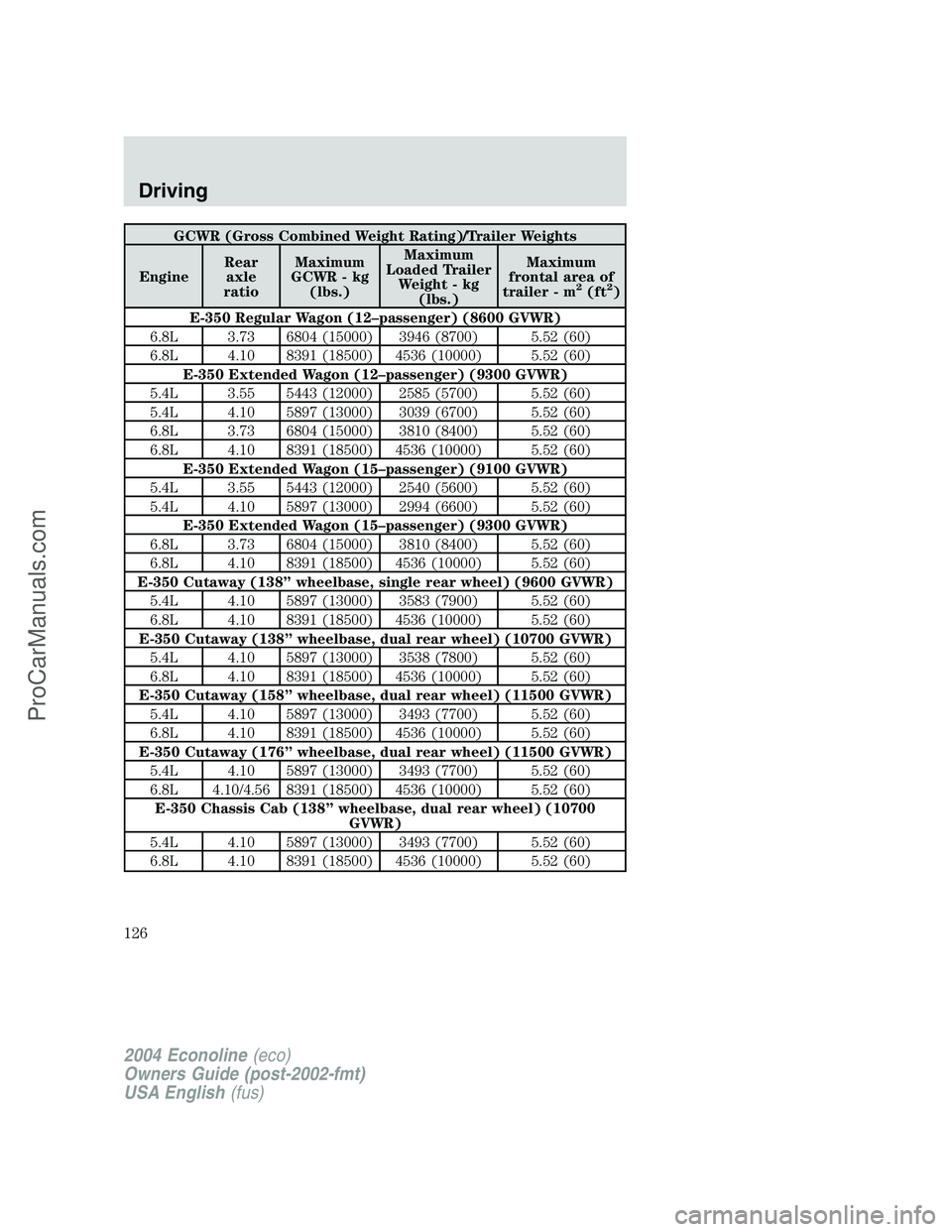
GCWR (Gross Combined Weight Rating)/Trailer Weights
EngineRear
axle
ratioMaximum
GCWR - kg
(lbs.)Maximum
Loaded Trailer
Weight - kg
(lbs.)Maximum
frontal area of
trailer - m
2(ft2)
E-350 Regular Wagon (12–passenger) (8600 GVWR)
6.8L 3.73 6804 (15000) 3946 (8700) 5.52 (60)
6.8L 4.10 8391 (18500) 4536 (10000) 5.52 (60)
E-350 Extended Wagon (12–passenger) (9300 GVWR)
5.4L 3.55 5443 (12000) 2585 (5700) 5.52 (60)
5.4L 4.10 5897 (13000) 3039 (6700) 5.52 (60)
6.8L 3.73 6804 (15000) 3810 (8400) 5.52 (60)
6.8L 4.10 8391 (18500) 4536 (10000) 5.52 (60)
E-350 Extended Wagon (15–passenger) (9100 GVWR)
5.4L 3.55 5443 (12000) 2540 (5600) 5.52 (60)
5.4L 4.10 5897 (13000) 2994 (6600) 5.52 (60)
E-350 Extended Wagon (15–passenger) (9300 GVWR)
6.8L 3.73 6804 (15000) 3810 (8400) 5.52 (60)
6.8L 4.10 8391 (18500) 4536 (10000) 5.52 (60)
E-350 Cutaway (138”wheelbase, single rear wheel) (9600 GVWR)
5.4L 4.10 5897 (13000) 3583 (7900) 5.52 (60)
6.8L 4.10 8391 (18500) 4536 (10000) 5.52 (60)
E-350 Cutaway (138”wheelbase, dual rear wheel) (10700 GVWR)
5.4L 4.10 5897 (13000) 3538 (7800) 5.52 (60)
6.8L 4.10 8391 (18500) 4536 (10000) 5.52 (60)
E-350 Cutaway (158”wheelbase, dual rear wheel) (11500 GVWR)
5.4L 4.10 5897 (13000) 3493 (7700) 5.52 (60)
6.8L 4.10 8391 (18500) 4536 (10000) 5.52 (60)
E-350 Cutaway (176”wheelbase, dual rear wheel) (11500 GVWR)
5.4L 4.10 5897 (13000) 3493 (7700) 5.52 (60)
6.8L 4.10/4.56 8391 (18500) 4536 (10000) 5.52 (60)
E-350 Chassis Cab (138”wheelbase, dual rear wheel) (10700
GVWR)
5.4L 4.10 5897 (13000) 3493 (7700) 5.52 (60)
6.8L 4.10 8391 (18500) 4536 (10000) 5.52 (60)
2004 Econoline(eco)
Owners Guide (post-2002-fmt)
USA English(fus)
Driving
126
ProCarManuals.com
Page 127 of 240
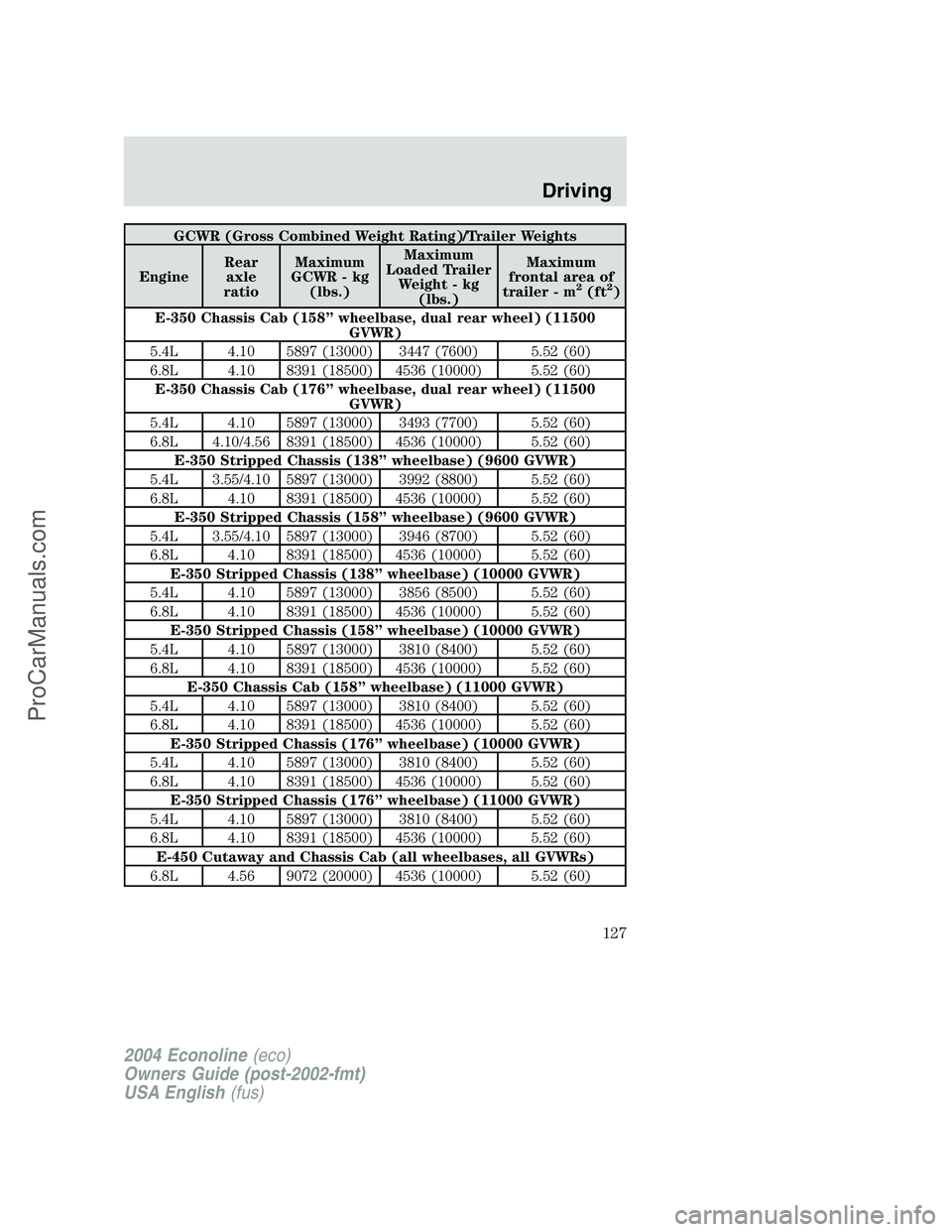
GCWR (Gross Combined Weight Rating)/Trailer Weights
EngineRear
axle
ratioMaximum
GCWR - kg
(lbs.)Maximum
Loaded Trailer
Weight - kg
(lbs.)Maximum
frontal area of
trailer - m
2(ft2)
E-350 Chassis Cab (158”wheelbase, dual rear wheel) (11500
GVWR)
5.4L 4.10 5897 (13000) 3447 (7600) 5.52 (60)
6.8L 4.10 8391 (18500) 4536 (10000) 5.52 (60)
E-350 Chassis Cab (176”wheelbase, dual rear wheel) (11500
GVWR)
5.4L 4.10 5897 (13000) 3493 (7700) 5.52 (60)
6.8L 4.10/4.56 8391 (18500) 4536 (10000) 5.52 (60)
E-350 Stripped Chassis (138”wheelbase) (9600 GVWR)
5.4L 3.55/4.10 5897 (13000) 3992 (8800) 5.52 (60)
6.8L 4.10 8391 (18500) 4536 (10000) 5.52 (60)
E-350 Stripped Chassis (158”wheelbase) (9600 GVWR)
5.4L 3.55/4.10 5897 (13000) 3946 (8700) 5.52 (60)
6.8L 4.10 8391 (18500) 4536 (10000) 5.52 (60)
E-350 Stripped Chassis (138”wheelbase) (10000 GVWR)
5.4L 4.10 5897 (13000) 3856 (8500) 5.52 (60)
6.8L 4.10 8391 (18500) 4536 (10000) 5.52 (60)
E-350 Stripped Chassis (158”wheelbase) (10000 GVWR)
5.4L 4.10 5897 (13000) 3810 (8400) 5.52 (60)
6.8L 4.10 8391 (18500) 4536 (10000) 5.52 (60)
E-350 Chassis Cab (158”wheelbase) (11000 GVWR)
5.4L 4.10 5897 (13000) 3810 (8400) 5.52 (60)
6.8L 4.10 8391 (18500) 4536 (10000) 5.52 (60)
E-350 Stripped Chassis (176”wheelbase) (10000 GVWR)
5.4L 4.10 5897 (13000) 3810 (8400) 5.52 (60)
6.8L 4.10 8391 (18500) 4536 (10000) 5.52 (60)
E-350 Stripped Chassis (176”wheelbase) (11000 GVWR)
5.4L 4.10 5897 (13000) 3810 (8400) 5.52 (60)
6.8L 4.10 8391 (18500) 4536 (10000) 5.52 (60)
E-450 Cutaway and Chassis Cab (all wheelbases, all GVWRs)
6.8L 4.56 9072 (20000) 4536 (10000) 5.52 (60)
2004 Econoline(eco)
Owners Guide (post-2002-fmt)
USA English(fus)
Driving
127
ProCarManuals.com